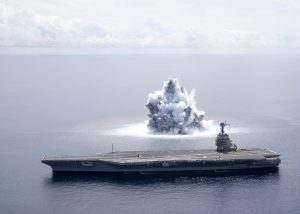The 11th and final Advanced Weapons Elevator (AWE) aboard the USS Gerald R. Ford (CVN-78) was completed and turned over to the ship’s crew on December 22.
The long-delayed elevators are one of the technical issues that has driven costs up on CVN-78, the Navy’s newest aircraft carrier. The AWEs are a new technology that use electromagnetic motors and are designed to move ordnance through the ship more quickly with enhanced carrying capacity as well as reduced manning, maintenance and total ownership costs.
“The advanced technology enables fewer sailors to safely move ordnance from weapons magazines to the flight deck with unparalleled speed and agility,” the Navy said in a statement
This milestone was marked amid the ship’s six month Planned Incremental Availability (PIA) which is expected to be finished by February 2022.

During this PIA, the Navy is conducting additional inspections to assess and fix any damage from the shock trials and continue remaining modernization and sustainment work before moving on to workups and training in the spring for the Ford’s first deployment, planned in 2022.
The PIA work is being done while the carrier is at the Huntington Ingalls Industries’ [HII] Newport News Shipbuilding facility in Hampton Roads, Va. HII also builds the AWEs.
“This is a significant milestone for the Navy, ship, and her crew. With completion of this final AWE, we now have the entire system to operate and train with,” Rear Adm. James, Downey, Program Executive Officer for Aircraft Carriers, said in a statement,
“The Navy-Industry teaming provided the opportunities for hundreds of craftsmen, technicians and engineers, working around the clock—through multiple underway and holiday periods—to get these advanced systems on line and operational,” he continued.
Downey noted the ultimate factor is operational readiness “and Ford is on track to complete this PIA on schedule, conduct sea trials, and to move on to follow on tasking.”
Previously, the Ford finished an 18-month Post-Delivery Test and Trials (PDT&T) period last April (Defense Daily, May 5) before moving on to full ship shock trials that wrapped up in August (Defense Daily, Aug. 10).
When the PDT&T period ended, Downey noted CVN-78 cycled the first seven AWEs over 14,200 times, “with close to half of those evolutions at sea.”
The AWEs were the last new technology to be fixed and completed, so the Navy allowed the crew and air wing to start training during the PDT&T and undergo shock trials while contractors worked on the elevators both in-port and while at sea.
After numerous delays, this year the Navy’s timelines on elevator completion have been more accurate.
In July, Chief of Naval Operations Adm. Mike Gilday said HII had delivered seven elevators with two more to be delivered by the fall and the last two before the end of the year (Defense Daily, July 21).
At the time, Gilday said in this process the service learned the importance of using land-based testing on new systems before introducing them to the fleet.
“The ammunition elevators are an exceptional example of a painful process over the past four or five years. And so we are in the – in the ’21 budget we already have money dedicated to land-based test sites for the frigate so that we can perfect that technology before we – before we deliver it to the ship,” Gilday said.